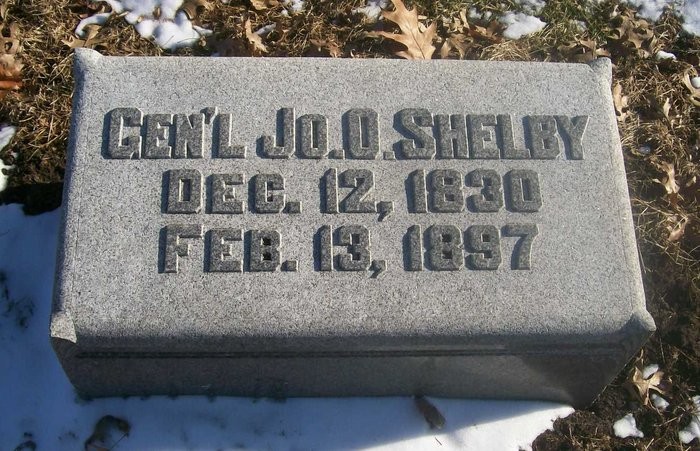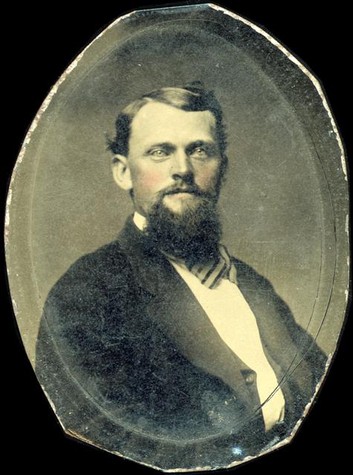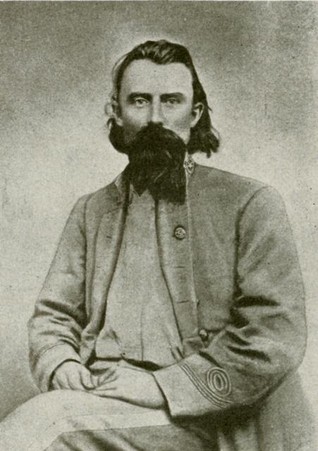Gravesite of Joseph Orville "Jo" Shelby (1830-1897)
Introduction
Text-to-speech Audio
This is the burial site of Joseph Orville "Jo" Shelby, a man whose wealth came from the labor of the families he enslaved and who is best known for attacking abolitionists and leading Confederate raids during the Civil War. Shelby was born to a wealthy Kentucky family and moved to Waverly, Missouri, where the labor of enslaved people made him one of the wealthiest people in the area. Shelby operated a 700-acre plantation and ropeworks. An ardent defender of slavery, Shelby sided with Missourians who attacked Free Staters in Kansas after the Kansas-Nebraska Act was passed in 1854. Shelby organized proslavery partisans during Bleeding Kansas, but towards the end of his life, Shelby expressed regrets for his violent actions against Kansans who opposed slavery in the crisis known as "Bleeding Kansas." When the Civil War started, Shelby led cavalry units for the Confederate army. Shelby remains widely regarded as an effective cavalry leader in raids against U.S. Army troops throughout Missouri. He also commanded troops in the Battle of Wilson's Creek and led a division during Price's Missouri Expedition before leading his remaining troops to Mexico to avoid surrender at the end of the Civil War. After the war, Shelby eventually returned to Missouri where he was a farmer. Late in life, Shelby was a U.S. Marshall and in this capacity, he appointed an African-American man as a Deputy U.S. Marshal, an action that was met with controversy. Shelby later voiced regret for the actions he took in Kansas. He told historian William Elsey Connelly: “I was in Kansas at the head of an armed force. I was there to kill Free-state men. I did kill them. I am now ashamed of myself for having done so.”
Images
General Joseph Shelby's grave marker.

Joseph Shelby on his wedding day in 1858.

Brigadier General Joseph Shelby

Backstory and Context
Text-to-speech Audio
General Joseph Orville “Jo” Shelby was born on December 12th, 1830 in Lexington, Kentucky. His father was a wealthy planter and hemp rope producer who died when Shelby was five. Shelby was raised by his stepfather Benjamin Gratz who was also part of the wealthy elite of Lexington. Shelby attended Transylvania University, where he was poised to become a successful businessman. Following his time at the university, he became a rope manufacturer until he moved to Waverly, Missouri, in 1852. There, he and his stepbrother Henry Howard Gratz opened the Waverly Steam Rope Company, which used the labor of enslaved people. In Missouri, Shelby also owned a 700-acre plantation operated by enslaved people. He became one of the wealthiest men in the state. In 1857, Shelby married Elizabeth Nancy Shelby, a distant cousin, and they had seven children together.
Shelby became involved in the Bleeding Kansas conflict after the Kansas-Nebraska Act was passed in 1854. In response to the Act, the New England Emigrant Aid Company was formed in which northern abolitionists were paid to move to Kansas and prevent it from becoming a slave state. Missourians subsequently formed the Blue Lodge, which was dedicated to making Kansas a slave state. Shelby was involved in the Blue Lodge, and went to Lawrence, Kansas during the March 30th, 1855 election to illegally vote and harass abolitionists. His involvement with the issue damaged his business and his relationship with his stepbrother, causing his brother to move back to Lexington. Shelby had to sell his rope company, plantation, and the people he enslaved.
Following the attack on Fort Sumter in 1861 that officially marked the beginning of the Civil War, Governor Claiborn Fox Jackson refused Lincoln’s call for troops and attempted to secede. Joseph Shelby formed the Lafayette County Mounted Rifles to fight for the Missouri State Guard, which was formed by Governor Jackson to drive the Union troops out of Missouri, in response to the Camp Jackson Affair. The Camp Jackson Affair occurred on May 10, 1861 when Union Captain Nathaniel Lyon led 6,000 volunteers and U.S. Regulars against the secessionist Camp Jackson arsenal. Lyon and his men captured 669 men and marched them through St. Louis, which sparked a riot. The volunteers fired into the crowds, killing 28 onlookers and wounding 100 more.
Shelby led the Lafayette County Mounted Rifles into battle at Carthage, Wilson’s Creek, and Pea Ridge. In 1862, he was promoted to Colonel and ordered to recruit men for a Confederate Cavalry regiment. For this, he returned to Lafayette County and, after bringing the recruits back to Arkansas, he was given command of the new brigade which has been nicknamed the “Iron Brigade” for their toughness. In 1863, Shelby led the Iron Brigade on what was then the longest cavalry raid of the war, dubbed “Shelby’s Raid.” The raid lasted from September 22nd to November 3rd, 1863. Major John Newman Edwards reported that the raid resulted in“1,500 miles traveled, 600 killed and wounded, and 500 captured and paroled,” though this was likely exaggerated. The raid’s purpose was to divert Federal troops, which they failed in accomplishing.
Nonetheless, on December 15th, 1863, Shelby was promoted to brigadier-general. In 1864, Shelby, along with other Confederate forces, successfully disrupted General Frederick Steele’s Camden Expedition that lasted from March 23rd to May 2nd. General Steele’s forces were forced to retreat to Little Rock after their supply trains were captured and destroyed at the Battle of Marks’ Mills.
Shelby went on to command a division during Price’s Missouri Expedition, a failed Confederate raid through Arkansas, Missouri, and Kansas led by General Sterling Price. After Robert E. Lee’s surrender at Appomattox, Shelby was promoted to major general but this was never formalized because the Confederate government collapsed. Despite Lee’s surrender, Shelby refused to give up and in June of 1865, he led his troops (nicknamed “The Undefeated”) to Mexico. He offered their services as a foreign legion to Emperor Maximilian, who declined but granted them land for an American colony near Vera Cruz called Carlota. The land grant was revoked two years later when the Second Mexican Empire fell, and Maximilian was executed.
Shelby subsequently returned to Missouri and took up farming again. In 1893, he was appointed U.S. Marshal for the Western District of Missouri by President Grover Cleveland, a position he maintained until his death. Shelby appointed an African American man as the Deputy U.S. Marshal, which was met with controversy. He defended his actions, saying: “I am right in what I have done, and by the right I propose to stand.” Shelby later voiced regret for the actions he took in Kansas. He told historian William Elsey Connelly: “I was in Kansas at the head of an armed force. I was there to kill Free-state men. I did kill them. I am now ashamed of myself for having done so. I had no business there. No Missourian had any business there with arms in his hands.” General Joseph Shelby died of pneumonia at his farm near Adrian, Missouri, on February 13th, 1897, at age 66.
Cite This Entry
Herndon, Sarah and Clio Admin. "Gravesite of Joseph Orville "Jo" Shelby (1830-1897)." Clio: Your Guide to History. September 18, 2023. Accessed April 11, 2025. https://theclio.com/entry/167866
Sources
Christopher, Phillips. Shelby, Joseph Orville, Civil War on the Western Border. Accessed May 5th, 2023. https://civilwaronthewesternborder.org/encyclopedia/shelby-joseph-orville.
Mark, Christ K.. Joseph Orville Shelby (1830–1897), Encyclopedia of Arkansas. December 6th, 2021. Accessed May 5th, 2023. https://encyclopediaofarkansas.net/entries/joseph-orville-shelby-7017/.
Joseph O. Shelby, Historic Missourians (State Historical Society of Missouri). Accessed May 5th, 2023. https://historicmissourians.shsmo.org/?page_id=4741.
Camp Jackson Affair, Civil War on the Western Border. Accessed May 5th, 2023. https://civilwaronthewesternborder.org/timeline/camp-jackson-affair.
Terry, Beckenbaugh. Shelby's Raid, Civil War on the Western Border. https://civilwaronthewesternborder.org/encyclopedia/shelby%E2%80%99s-raid.
Jackson, Claiborne Fox, Civil War on the Western Border. Accessed May 5th, 2023. https://civilwaronthewesternborder.org/encyclopedia/jackson-claiborne-fox.
Find a Grave (Steve McCray)
State Historical Society of Missouri
State Historical Society of Missouri

